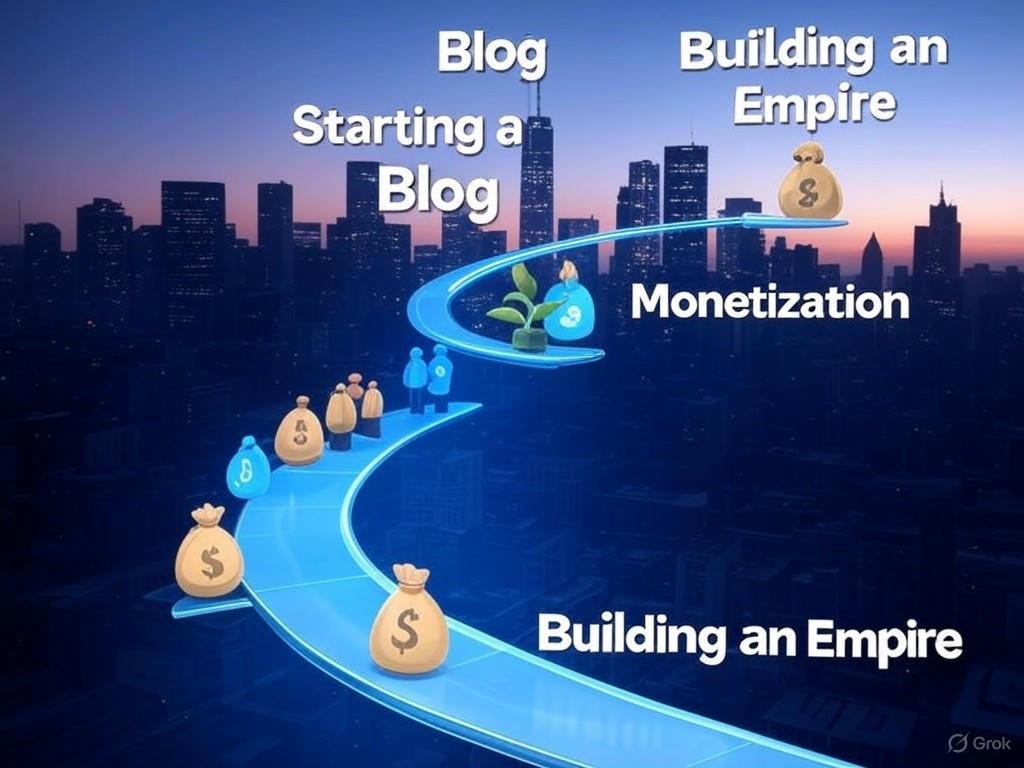Blogging has evolved from a simple hobby into a legitimate career path for those willing to put in the work. If you’re wondering how to become a blogger and make money, you’re not alone. Thousands of people are drawn to the idea of earning a living by sharing their passions, expertise, or stories online. But turning a blog into a profitable venture isn’t about throwing up a website and hoping for the best. It requires strategy, dedication, and a clear understanding of what makes a blog successful. In this comprehensive guide, I’ll walk you through the essential steps to launch a blog, grow your audience, and monetize your efforts like a pro. Whether you’re a beginner or looking to level up, this article will equip you with actionable insights to build your online empire.
Why Blogging? The Appeal of a Flexible, Profitable Career

Blogging offers unparalleled freedom. You can work from anywhere, set your own hours, and write about topics you love. But the real draw? The potential to generate significant income. According to industry reports, top bloggers can earn anywhere from $5,000 to $50,000 a month or more through various revenue streams like affiliate marketing, sponsored posts, and digital products. Even part-time bloggers can bring in a steady side income. The key is to approach blogging with a business mindset, combining creativity with strategic planning.
However, success doesn’t happen overnight. Blogging is a long game, and it requires patience, persistence, and a willingness to learn. If you’re ready to commit, let’s dive into the steps to start a blog and make money.
Step 1: Find Your Niche and Define Your Unique Voice
The first step to becoming a successful blogger is choosing a niche—a specific topic or area of expertise that your blog will focus on. Your niche should align with your passions, knowledge, and audience demand. A well-defined niche helps you stand out in a crowded online space and attract a loyal audience.
How to Choose a Profitable Blogging Niche
- Identify Your Passions and Skills: What are you knowledgeable about? What topics could you write about endlessly? For example, if you’re a fitness enthusiast, you might focus on workout routines, nutrition tips, or wellness for busy professionals.
- Research Market Demand: Use tools like Google Trends, AnswerThePublic, or BuzzSumo to see what people are searching for. High-demand niches like personal finance, health, travel, and lifestyle tend to have strong monetization potential.
- Evaluate Competition: A niche with some competition is a good sign—it means there’s an audience. But avoid oversaturated topics unless you can offer a fresh perspective. For instance, instead of a generic “travel blog,” focus on “budget travel for families” or “solo female travel in Asia.”
- Consider Monetization Potential: Some niches, like technology or finance, have higher-paying affiliate programs and sponsorship opportunities. Research how other bloggers in your niche are making money.
Once you’ve chosen your niche, develop a unique voice. Are you witty and conversational, like a friend sharing advice? Or authoritative and data-driven, like a professor? Your voice sets the tone for your brand and helps you connect with readers.
Read more: How to Make Money on Poshmark: A Blogger’s Guide to Turning Your Closet into Cash
Step 2: Set Up Your Blog the Right Way
A professional blog starts with a solid foundation. Here’s how to get your blog up and running.
Choose a Reliable Blogging Platform
WordPress.org is the gold standard for bloggers who want full control and monetization flexibility. It’s customizable, SEO-friendly, and widely supported. Avoid free platforms like WordPress.com or Blogger for serious blogging, as they limit your ability to monetize and scale.
Select a Domain Name and Hosting
Your domain name is your blog’s address (e.g., www.yourblog.com). Choose something memorable, brandable, and relevant to your niche. For example, a food blog might use “TastyBites.com.” Avoid overly long or complicated names.
For hosting, opt for reputable providers like Bluehost, SiteGround, or WP Engine. These services store your blog’s files and ensure it’s accessible online. Look for plans with fast loading times, reliable uptime, and good customer support. Expect to pay $3–$10 per month for basic hosting.
Design a User-Friendly Blog
A clean, professional design builds trust with your audience. Choose a responsive WordPress theme (like Astra or GeneratePress) that looks great on both desktop and mobile. Prioritize fast loading speeds, easy navigation, and a clutter-free layout. Invest in a premium theme if your budget allows—it’s worth the $50–$100 for a polished look.
Install Essential Plugins
Plugins extend your blog’s functionality. Must-haves include:
- Yoast SEO or Rank Math for optimizing your content for search engines.
- WP Rocket or W3 Total Cache for speeding up your site.
- UpdraftPlus for backups.
- MonsterInsights for tracking analytics.
With your blog set up, you’re ready to create content that attracts readers and lays the groundwork for monetization.
Step 3: Create High-Quality, Audience-Focused Content
Content is the heart of your blog. To stand out and rank well on search engines, your posts need to be valuable, engaging, and optimized for search.
Write for Your Audience
Understand who your readers are and what they’re looking for. Are they beginners seeking step-by-step guides? Experts looking for advanced tips? Use tools like Google Keyword Planner or Ahrefs to find popular search terms in your niche, such as “how to start a blog and make money” or “best blogging tips for beginners.”
Craft Compelling Content
- Write In-Depth Posts: Aim for 1,500–3,000 words for cornerstone content like this article. Long-form content tends to rank better and provides more value.
- Use a Conversational Tone: Write as if you’re speaking to a friend. Avoid jargon unless your audience expects it.
- Include Actionable Advice: Readers love practical tips they can apply immediately. For example, instead of saying “promote your blog,” explain how to share posts on Pinterest or engage in niche-specific forums.
- Add Visuals: Use high-quality images, infographics, or videos to break up text and enhance engagement. Tools like Canva make it easy to create professional visuals.
Optimize for SEO
Search engine optimization (SEO) helps your blog rank higher on Google, driving organic traffic. Key strategies include:
- Keyword Research: Incorporate your main keyword (“how to become a blogger and make money”) and related terms (e.g., “start a blog and earn income,” “blogging for profit”) naturally throughout your content.
- Optimize Titles and Headings: Use your keyword in the title, introduction, and at least one subheading. For example, this article’s title targets the main keyword while remaining engaging.
- Write Meta Descriptions: Craft a 150–160-character summary of your post that includes your keyword and entices readers to click.
- Use Internal and External Links: Link to other posts on your blog and reputable external sources to boost credibility and SEO.
Consistency is key. Aim to publish 1–2 high-quality posts per week to build momentum and keep readers coming back.
Read more: RocketClips AI review – A Comprehensive Insight into AI-Driven Video Editing
Step 4: Grow Your Audience and Build a Community
A blog without readers won’t make money. Focus on growing your audience through multiple channels.
Leverage Social Media
Share your posts on platforms where your audience hangs out. For example:
- Pinterest: Ideal for lifestyle, food, and travel blogs. Create eye-catching pins with tools like Canva.
- Instagram: Great for visual niches like fashion or fitness. Use Stories and Reels to engage followers.
- Twitter/X: Perfect for sharing quick tips and networking with other bloggers.
Build an Email List
Email marketing is one of the most effective ways to connect with your audience. Offer a freebie—like an eBook, checklist, or mini-course—in exchange for email sign-ups. Use platforms like Mailchimp or ConvertKit to manage your list and send newsletters.
Engage with Your Niche
Join online communities like Reddit, Quora, or niche-specific forums to answer questions and share your expertise. Guest post on other blogs to reach new audiences and build backlinks, which improve your SEO.
Network with Other Bloggers
Collaborate with bloggers in your niche for guest posts, interviews, or co-created content. Attend blogging conferences or join online groups to learn from others and stay motivated.
Step 5: Monetize Your Blog Like a Pro
Once you have an audience, it’s time to turn your blog into a money-making machine. Here are the most effective monetization strategies.
Affiliate Marketing
Affiliate marketing involves promoting products or services and earning a commission for each sale made through your links. Sign up for programs like Amazon Associates, ShareASale, or CJ Affiliate. Choose products that align with your niche and audience needs. For example, a tech blogger might promote gadgets, while a parenting blogger could recommend baby gear.
To succeed:
- Write honest reviews or tutorials featuring affiliate products.
- Disclose affiliate links to build trust (e.g., “This post contains affiliate links, which means I may earn a commission at no extra cost to you”).
- Use tools like Pretty Links to create clean, trackable URLs.
Sponsored Posts
Brands may pay you to write posts promoting their products or services. Rates vary widely—$50 for new bloggers to $5,000+ for established ones. Build a media kit showcasing your traffic, audience demographics, and engagement metrics to attract sponsors.
Sell Digital Products
Create and sell your own products, such as:
- eBooks: Write a guide on a topic you’re an expert in (e.g., “The Ultimate Guide to Budget Travel”).
- Online Courses: Use platforms like Teachable or Gumroad to create courses on your niche.
- Printables: Sell planners, templates, or checklists on Etsy or your blog.
Digital products have high profit margins and scale well since you create them once and sell them repeatedly.
Display Ads
Ad networks like Google AdSense or Mediavine display ads on your blog, paying you based on views or clicks. AdSense is beginner-friendly but pays less, while Mediavine requires at least 50,000 monthly sessions for higher earnings. Optimize ad placement without compromising user experience.
Offer Services or Coaching
If you’re an expert in your niche, offer services like consulting, coaching, or freelance writing. For example, a finance blogger might provide financial planning sessions, while a fitness blogger could offer personal training.
Read more: 10 Proven Ways to Make Extra Income from Home – Your Ultimate Guide to Financial Freedom
Step 6: Scale Your Blog and Maximize Earnings

As your blog grows, focus on scaling your income and impact.
- Diversify Revenue Streams: Don’t rely on one monetization method. Combine affiliate marketing, ads, and digital products for stability.
- Hire Help: Outsource tasks like graphic design or content writing to free up time for strategy and growth.
- Analyze Performance: Use Google Analytics and Search Console to track traffic, popular posts, and user behavior. Double down on what works.
- Stay Updated: Blogging trends evolve. Follow blogs like ProBlogger or Smart Blogger to stay ahead of the curve.
Common Pitfalls to Avoid
- Chasing Trends: Don’t jump into a niche just because it’s popular. Passion and expertise keep you motivated long-term.
- Neglecting SEO: Without optimization, your blog will struggle to rank on Google.
- Inconsistent Posting: Sporadic updates lead to lost readers. Stick to a schedule.
- Ignoring Your Audience: Engage with comments, emails, and social media to build loyalty.
The Long-Term Vision: Building Your Blogging Empire
Becoming a blogger and making money is a journey, not a sprint. It takes time to build traffic, authority, and income. Most bloggers don’t see significant earnings until 6–12 months in, but those who stick with it can achieve life-changing results. Imagine earning a full-time income from your blog, working from a beach in Bali, or having the freedom to pursue your passions without financial stress. That’s the power of blogging done right.
To succeed, stay curious, experiment with new strategies, and keep your audience at the heart of everything you do. With dedication and the steps outlined above, you’ll be well on your way to mastering the art of blogging and building a profitable online empire.






